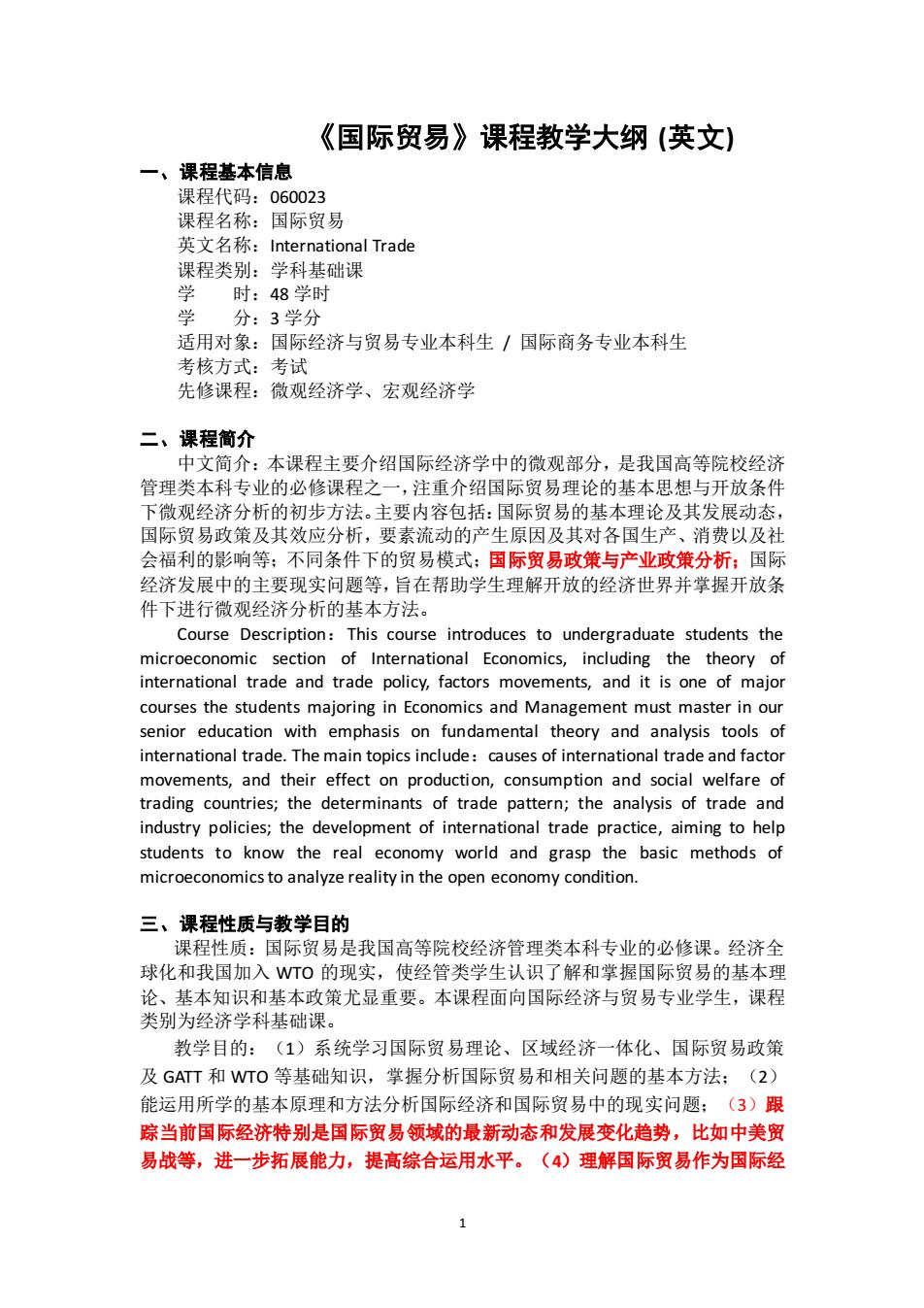
《国际贸易》课程教学大纲(英文) 一、课程基本信息 课程代码:060023 课程名称:国际贸易 英文名称:International Trade 课程类别:学科基础课 学 时:48学时 分:3学分 适用对象:国际经济与贸易专业本科生/国际商务专业本科生 考核方式:考试 先修课程:微观经济学、宏观经济学 二、课程简介 中文简介:本课程主要介绍国际经济学中的微观部分,是我国高等院校经济 管理类本科专业的必修课程之一,注重介绍国际贸易理论的基本思想与开放条件 下微观经济分析的初步方法。主要内容包括:国际贸易的基本理论及其发展动态, 国际贸易政策及其效应分析,要素流动的产生原因及其对各国生产、消费以及社 会福利的影响等:不同条件下的贸易模式:国际贸易政策与产业政策分析:国际 经济发展中的主要现实问题等,旨在帮助学生理解开放的经济世界并掌握开放条 件下进行微观经济分析的基本方法。 Course Description:This course introduces to undergraduate students the suionuP P ope leuo ade and trade policy,factors movements, and courses the students majoring in Economics and Management must master in our senior education with emphasis on fundamental theory and analysis tools of international trade.The main topics include:causes of international trade and factor movements,and their effect on production,consumption and social welfare of trading co s the de nts of trade n;the analysis of trade and industry policies;the development of international trade practice,aiming to help students to know the real economy world and grasp the basic methods of microeconomics to analyze reality in the open economy condition. 三、课程性质与教学目的 课程性质:国际贸易是我国高等院校经济管理类本科专业的必修课。经济全 球化和我国加入WT的现实,使经管类学生认识了解和掌握国际贸易的基本理 论、基本知识和基本政策尤显重要。本课程面向国际经济与贸易专业学生,课程 类别为经济学科基础课。 教学目的:(1)系统学习国际贸易理论、区域经济一体化、国际贸易政策 及GATT和WTO等基础知识,掌握分析国际贸易和相关问题的基本方法:(2) 能运用所学的基本原理和方法分析国际经济和国际贸易中的现实问题:(3)跟 踪当前国际经济特别是国际贸易领域的最新动态和发展变化趋势,比如中美贸 易战等,进一步拓展能力,提高综合运用水平。(4)理解国际贸易作为国际经
1 《国际贸易》课程教学大纲 (英文) 一、课程基本信息 课程代码:060023 课程名称:国际贸易 英文名称:International Trade 课程类别:学科基础课 学 时:48 学时 学 分:3 学分 适用对象:国际经济与贸易专业本科生 / 国际商务专业本科生 考核方式:考试 先修课程:微观经济学、宏观经济学 二、课程简介 中文简介:本课程主要介绍国际经济学中的微观部分,是我国高等院校经济 管理类本科专业的必修课程之一,注重介绍国际贸易理论的基本思想与开放条件 下微观经济分析的初步方法。主要内容包括:国际贸易的基本理论及其发展动态, 国际贸易政策及其效应分析,要素流动的产生原因及其对各国生产、消费以及社 会福利的影响等;不同条件下的贸易模式;国际贸易政策与产业政策分析;国际 经济发展中的主要现实问题等,旨在帮助学生理解开放的经济世界并掌握开放条 件下进行微观经济分析的基本方法。 Course Description:This course introduces to undergraduate students the microeconomic section of International Economics, including the theory of international trade and trade policy, factors movements, and it is one of major courses the students majoring in Economics and Management must master in our senior education with emphasis on fundamental theory and analysis tools of international trade. The main topics include:causes of international trade and factor movements, and their effect on production, consumption and social welfare of trading countries; the determinants of trade pattern; the analysis of trade and industry policies; the development of international trade practice, aiming to help students to know the real economy world and grasp the basic methods of microeconomics to analyze reality in the open economy condition. 三、课程性质与教学目的 课程性质:国际贸易是我国高等院校经济管理类本科专业的必修课。经济全 球化和我国加入 WTO 的现实,使经管类学生认识了解和掌握国际贸易的基本理 论、基本知识和基本政策尤显重要。本课程面向国际经济与贸易专业学生,课程 类别为经济学科基础课。 教学目的:(1)系统学习国际贸易理论、区域经济一体化、国际贸易政策 及 GATT 和 WTO 等基础知识,掌握分析国际贸易和相关问题的基本方法;(2) 能运用所学的基本原理和方法分析国际经济和国际贸易中的现实问题;(3)跟 踪当前国际经济特别是国际贸易领域的最新动态和发展变化趋势,比如中美贸 易战等,进一步拓展能力,提高综合运用水平。(4)理解国际贸易作为国际经

济的重要组成部分,深受政治因素的影响。党的十九届五中全会指出,当今世 界正经历百年未有之大变局,新一轮科技革命和产业变革深入发展,国际力量 对比深刻调整,和平与发展仍然是时代主题,人类命运共同体理念深入人心, 同时国际环境日趋复杂,不稳定性不确定性明显增加一方面国际贸易日益成为 国际政治和外交目标实现的有效途径,另一方面国际政治冲突甚至战争都不可 避免地把贸易优惠或制裁作为外交制衡杠杠。国际贸易会因国际政治冲突而存 在风险,也会因为国际政治和谐而紫荣昌盛。 四、教学内容 Chapter1:Introduction 1.1 Importance of International Ecconomics 1.2 International trade and the National Standard of Living 1.3 The Subject Matter of International Economics 1.4 Purpose of InternationalEconomic and Policies 1.5 Current Problems in the Field of International Trade 1.5A Trade Protectionism in Industrial Countries (Curriculum ideology:Discuss the causes of trade disputes between China and United States,so that students should understand the international economic situation and establish a correct world outlook) 1.5B High Structural Unemployment and Slow Growth in Europe and Stagnation in Japan 1.5C Job Insecurity from Restructuring and Downsizing in U.S. 1.5D Restructuring Problems of Transition Economies Chapter 2:The Law of Comparative Advantage 2.1 Introdiction:Brief Outline of the Law 2.2 The mercantilism's view on Trade:Case Study and illustration.recalling of the History Advantage:view of olue dvantage bym Smth,thstratior 2.4 Trade Based on Comparative Advantage:David Ricardo 2.4A The Law of Comparative Advantage:Tables,Figures and Examples 2.4B The Gains from Trade Law of Comp ative Advantage 2.4D Compar Advantage with Money Curriculum ideology:Understand comparative advantage theory,how to create trade advantage in internationaltrade) 2.5 Comparative Advantage and Opportunity Costs tunity 2
2 济的重要组成部分,深受政治因素的影响。党的十九届五中全会指出,当今世 界正经历百年未有之大变局,新一轮科技革命和产业变革深入发展,国际力量 对比深刻调整,和平与发展仍然是时代主题,人类命运共同体理念深入人心, 同时国际环境日趋复杂,不稳定性不确定性明显增加.一方面国际贸易日益成为 国际政治和外交目标实现的有效途径,另一方面国际政治冲突甚至战争都不可 避免地把贸易优惠或制裁作为外交制衡杠杠。国际贸易会因国际政治冲突而存 在风险,也会因为国际政治和谐而繁荣昌盛。 四、教学内容 Chapter 1: Introduction 1.1 Importance of International Ecconomics 1.2 International trade and the National Standard of Living 1.3 The Subject Matter of International Economics 1.4 Purpose of International Economic and Policies 1.5 Current Problems in the Field of International Trade 1.5A Trade Protectionism in Industrial Countries (Curriculum ideology:Discuss the causes of trade disputes between China and United States,so that students should understand the international economic situation and establish a correct world outlook) 1.5B High Structural Unemployment and Slow Growth in Europe and Stagnation in Japan 1.5C Job Insecurity from Restructuring and Downsizing in U.S. 1.5D Restructuring Problems of Transition Economies Chapter 2: The Law of Comparative Advantage 2.1 Introdiction: Brief Outline of the Law 2.2 The Mercantilism’s View on Trade: Case Study and Illustration, recalling of the History 2.3 Trade Basis on Absolute Advantage: View of Absolute Advantage by Adam Smith, Illustration of Absolute Advantage 2.4 Trade Based on Comparative Advantage: David Ricardo 2.4A The Law of Comparative Advantage: Tables, Figures and Examples 2.4B The Gains from Trade 2.4C Exception to the Law of Comparative Advantage 2.4D Comparative Advantage with Money (Curriculum ideology:Understand comparative advantage theory, how to create trade advantage in international trade) 2.5 Comparative Advantage and Opportunity Costs 2.5A Comparative Advantage and the Labour Theory of Value 2.5B The Opportunity Cost Theory
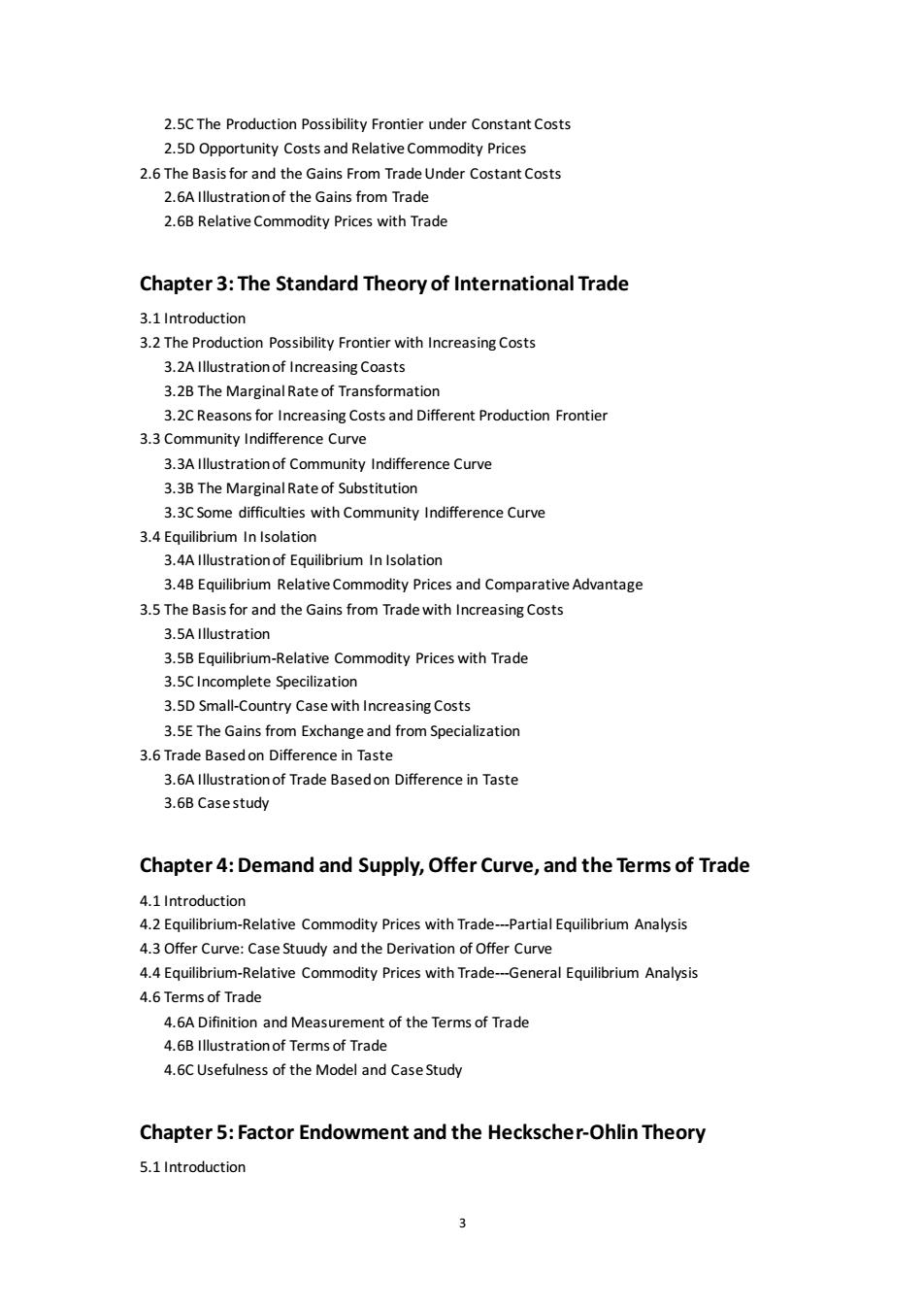
2.5C The Production Possibility Frontier under Constant Costs 2.5D Opportunity Costsand Relative Commodity Prices eUnder Costant Costs 2.6A Illustration of the Gains from Trade 2.6B Relative Commodity Prices with Trade Chapter 3:The Standard Theory of International Trade 3.2 The Production Possibility Frontier with Increasing Costs 3.2A lllustration of Increasing Coasts 3.2B The Marginal Rate of Transformation 3.CReasonsfor reasing Costsand Different Production Frontie 3.3 Community Indifference Curve 3.3A Illustration of Community Indifference Curve 3.3B The Marginal Rate of Substitution 3.3C Some difficulties with Community Indifference Curve 3.4A Illust on of Equilibrium In Isolation lative Commodity Prices and Comparative Advantage 3.5 The Basis for and the Gains from Trade with Increasing Costs 3 5A lllustration 3.5B Equilibrium-Relative commodity prices with trade 3.5D Small-Country Case with Increasing Costs 3.5E The Gains from Exchange and from Specialization 3.6 Trade Basedon Difference in Taste 3.6A lllustration of Trade Based on Difference in Taste 3 6B Case study Chapter 4:Demand and Supply,Offer Curve,and the Terms of Trade 4 1 Introduction 4.2 Equilibrium-Relative Commodity Prices with Trade-Partial Equilibrium Analysis 4.3 Offer Curve:CaseStuudy and the Derivation of Offer Curve 4.4 Equilibrium-Relative Commodity Prices with Trade-General Equilibrium Analysis 4.6 Terms of Trade 4.6A Difinition and Measurement of the Terms of Trade 4.6B Illustration of Terms of Trade 4.6C Usefulness of the Model and Case Study Chapter 5:Factor Endowment and the Heckscher-Ohlin Theory 5.1 Introduction
3 2.5C The Production Possibility Frontier under Constant Costs 2.5D Opportunity Costs and Relative Commodity Prices 2.6 The Basis for and the Gains From Trade Under Costant Costs 2.6A Illustration of the Gains from Trade 2.6B Relative Commodity Prices with Trade Chapter 3: The Standard Theory of International Trade 3.1 Introduction 3.2 The Production Possibility Frontier with Increasing Costs 3.2A Illustration of Increasing Coasts 3.2B The Marginal Rate of Transformation 3.2C Reasons for Increasing Costs and Different Production Frontier 3.3 Community Indifference Curve 3.3A Illustration of Community Indifference Curve 3.3B The Marginal Rate of Substitution 3.3C Some difficulties with Community Indifference Curve 3.4 Equilibrium In Isolation 3.4A Illustration of Equilibrium In Isolation 3.4B Equilibrium Relative Commodity Prices and Comparative Advantage 3.5 The Basis for and the Gains from Trade with Increasing Costs 3.5A Illustration 3.5B Equilibrium-Relative Commodity Prices with Trade 3.5C Incomplete Specilization 3.5D Small-Country Case with Increasing Costs 3.5E The Gains from Exchange and from Specialization 3.6 Trade Based on Difference in Taste 3.6A Illustration of Trade Based on Difference in Taste 3.6B Case study Chapter 4: Demand and Supply, Offer Curve, and the Terms of Trade 4.1 Introduction 4.2 Equilibrium-Relative Commodity Prices with Trade---Partial Equilibrium Analysis 4.3 Offer Curve: Case Stuudy and the Derivation of Offer Curve 4.4 Equilibrium-Relative Commodity Prices with Trade---General Equilibrium Analysis 4.6 Terms of Trade 4.6A Difinition and Measurement of the Terms of Trade 4.6B Illustration of Terms of Trade 4.6C Usefulness of the Model and Case Study Chapter 5: Factor Endowment and the Heckscher-Ohlin Theory 5.1 Introduction
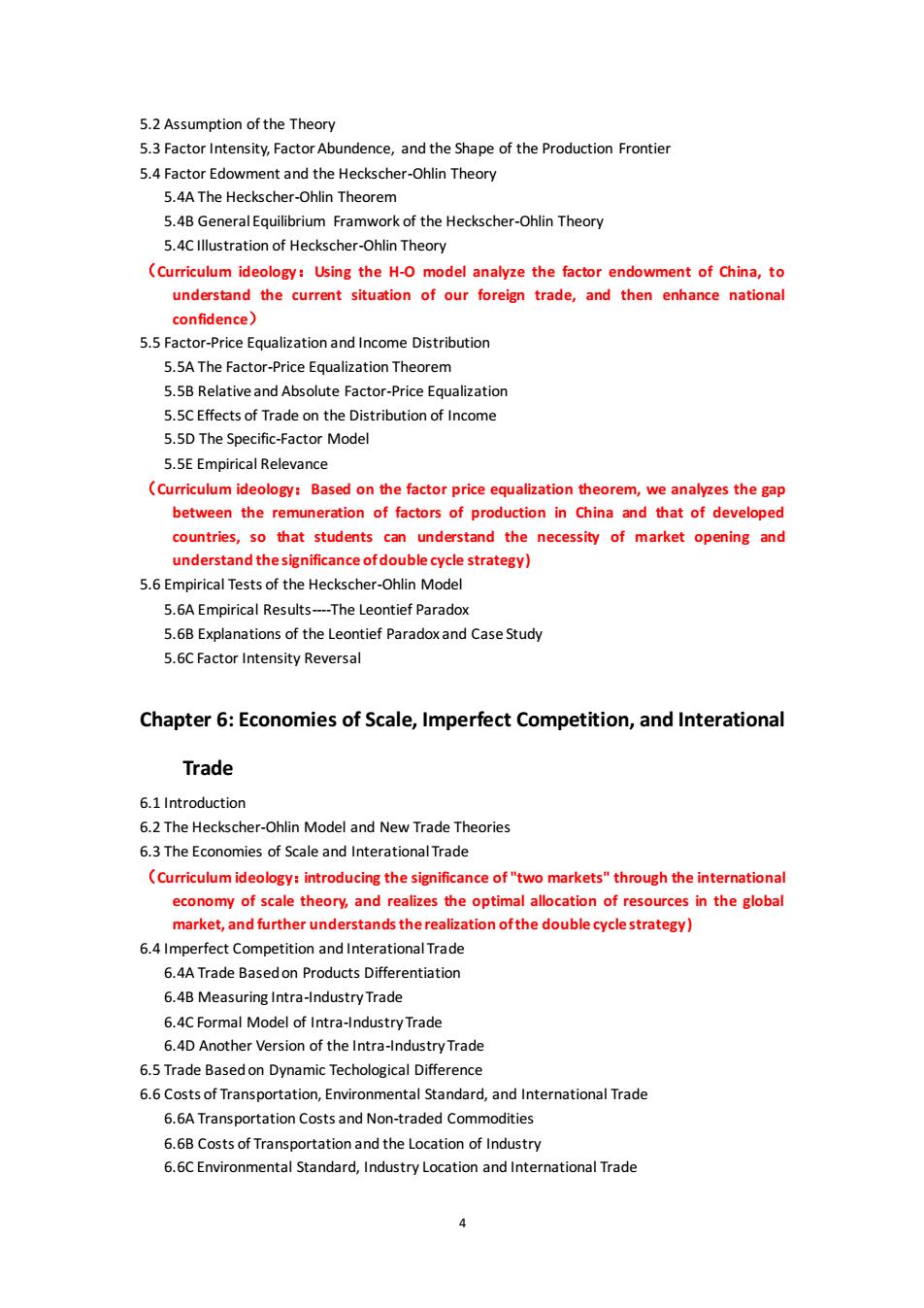
5.2 Assumption of the Theory 5.3 Factor Intensity.Factor Abundence.and the shape of the Production frontier Factordomnt h Heckscher-inTeor 5.4A The He 5.4B General Equilibrium Framwork of the Heckscher-Ohlin Theory 5.4C Illustration of Heckscher-Ohlin Theory (Curriculum ideology:Using the H-O model analyze the factor endowment of China,to stand the current of our foreign trade,and confidence) 5.Factor-Price Equalization and Income Distribution 5.5A The Factor-Price Equalization Theorem 5 58 Relative and absolute factor-Price fqualization 5 5C Effects of trade on the distribution of income 5.5D The Specific-Factor Model 5.5E Empirical Relevance (Curriculum ideology:Based on the factor price equalization theorem,we analyzes the gap between the remuneration of factors of production in China and that of developed countries,so that students can understand the necessity of market opening and stand thesignificance ofdouble 5.6A Empirical Results---The Leontief Paradox 5.6B Explanations of the Leontief Paradox and CaseStudy 5.6C Factor Intensity Reversal Chapter 6:Economies of Scale,Imperfect Competition,and Interational Trade 6.1 Introduction 6.2The Heckscher-hin Modeland New Trade Theories 6.3The Economies of Scale and nterationalTrade (Curriculum ideology:introducing the significance of "two markets"through the international economy of scale theory,and realizes the optimal allocation of resources in the global market,and further understands the realization ofthe double cycle strategy) 6.4B Measuring Intra-Industry Trad 6.4C Formal Model of Intra-Industry Trade 6.4D Another Version of the Intra-Industry Trade 6.Trade Basedon Dynamic Techological Differenc .6Costsof Transportation,Envir ental Standard,and nterational Trade 6.6A Transportation Costs and Non-traded Commodities 6.6B Costs of Transportation and the Location of Industry 6.6C Environmental Standard,Industry Location and International Trade
4 5.2 Assumption of the Theory 5.3 Factor Intensity, Factor Abundence, and the Shape of the Production Frontier 5.4 Factor Edowment and the Heckscher-Ohlin Theory 5.4A The Heckscher-Ohlin Theorem 5.4B General Equilibrium Framwork of the Heckscher-Ohlin Theory 5.4C Illustration of Heckscher-Ohlin Theory (Curriculum ideology:Using the H-O model analyze the factor endowment of China, to understand the current situation of our foreign trade, and then enhance national confidence) 5.5 Factor-Price Equalization and Income Distribution 5.5A The Factor-Price Equalization Theorem 5.5B Relative and Absolute Factor-Price Equalization 5.5C Effects of Trade on the Distribution of Income 5.5D The Specific-Factor Model 5.5E Empirical Relevance (Curriculum ideology:Based on the factor price equalization theorem, we analyzes the gap between the remuneration of factors of production in China and that of developed countries, so that students can understand the necessity of market opening and understand the significance of double cycle strategy) 5.6 Empirical Tests of the Heckscher-Ohlin Model 5.6A Empirical Results----The Leontief Paradox 5.6B Explanations of the Leontief Paradox and Case Study 5.6C Factor Intensity Reversal Chapter 6: Economies of Scale, Imperfect Competition, and Interational Trade 6.1 Introduction 6.2 The Heckscher-Ohlin Model and New Trade Theories 6.3 The Economies of Scale and Interational Trade (Curriculum ideology:introducing the significance of "two markets" through the international economy of scale theory, and realizes the optimal allocation of resources in the global market, and further understands the realization of the double cycle strategy) 6.4 Imperfect Competition and Interational Trade 6.4A Trade Based on Products Differentiation 6.4B Measuring Intra-Industry Trade 6.4C Formal Model of Intra-Industry Trade 6.4D Another Version of the Intra-Industry Trade 6.5 Trade Based on Dynamic Techological Difference 6.6 Costs of Transportation, Environmental Standard, and International Trade 6.6A Transportation Costs and Non-traded Commodities 6.6B Costs of Transportation and the Location of Industry 6.6C Environmental Standard, Industry Location and International Trade
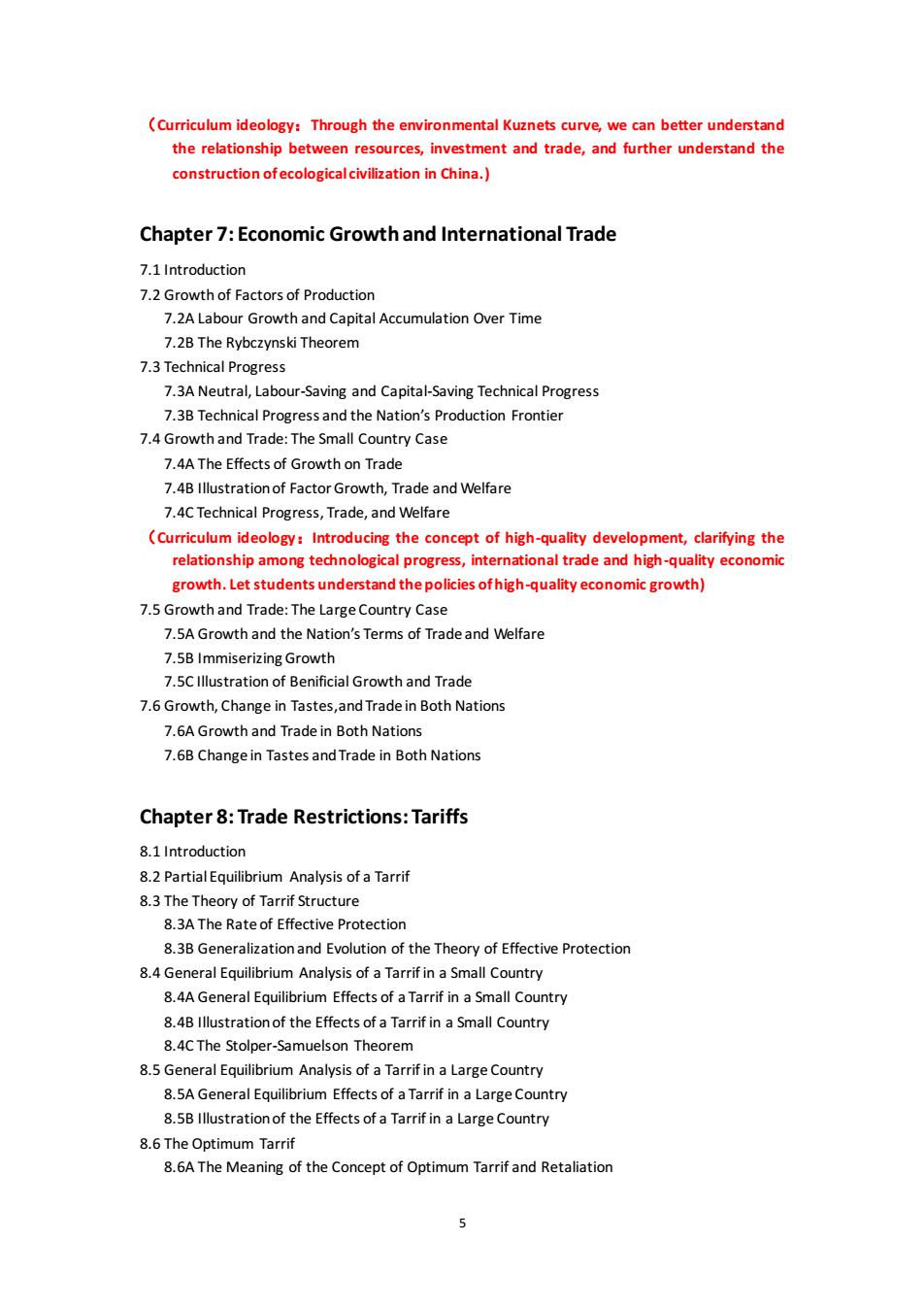
(Curriculum ideology:Through the environmental Kuznets curve,we can better understand the relationship between urces,investment and trade,and further understand the construction ofecologicalcivilization in China.) Chapter 7:Economic Growth and International Trade 7.1 Introduction 7.2Growth of Factors of Productior 7.2A Labour Growth and Capital Accumulation Over Time 7.2B The Rybczynski Theorem 7.3 Technical Progress 7.3A Neutral,Labour-Saving and Capital-Saving Technical Progress 7 38 Tec 7.4Gr The Small Country Case 7.4A The Effects of Growth on Trade 7.48 Illustration of Factor Growth.Trade and Welfare 7 AC Technical progress Trade and welfare (Curriculum ideology:Introducing the of high- e and high-qu growth.Let students understand thepolicies ofhigh-qualityeconomic growth) 7.5 Growth and Trade:The Large Country Case 7.5A Growth and the Nation's Terms of Trade and Welfare 7.5B Immiseri ne Growth th and trade 7.6Growth,Change in Tastes,and Tradein Both Nations 7.6A Growth and Trade in Both Nations 7.6B Change in tastes and Trade in both nations Chapter 8:Trade Restrictions:Tariffs 8.2 Partial Equilibrium Analysis of a Tarrif 8 3 The theory of tarrif Structure 8.3A The rate of Effective protection 8.4General Equilibrium Analysis of a Tarrifin a Small Country 8.4A General Equilibrium Effects of a Tarrif in a Small Country 8.4B Illustration of the Effects of a Tarrif in a Small Country 8 AC The Stolner.Samuelson Theorem .General Equiibrium Analysis of Large Country 8.5A General Equllibrium Effects of a Tarrif in a Large Country 8.5B lllustration of the Effects of a Tarrif in a Large Country 8.6The Optimum Tarrif 8.6A The Meaning of the Concept of Optimum Tarrif and Retaliation
5 (Curriculum ideology:Through the environmental Kuznets curve, we can better understand the relationship between resources, investment and trade, and further understand the construction of ecological civilization in China.) Chapter 7: Economic Growth and International Trade 7.1 Introduction 7.2 Growth of Factors of Production 7.2A Labour Growth and Capital Accumulation Over Time 7.2B The Rybczynski Theorem 7.3 Technical Progress 7.3A Neutral, Labour-Saving and Capital-Saving Technical Progress 7.3B Technical Progress and the Nation’s Production Frontier 7.4 Growth and Trade: The Small Country Case 7.4A The Effects of Growth on Trade 7.4B Illustration of Factor Growth, Trade and Welfare 7.4C Technical Progress, Trade, and Welfare (Curriculum ideology:Introducing the concept of high-quality development, clarifying the relationship among technological progress, international trade and high-quality economic growth. Let students understand the policies of high-quality economic growth) 7.5 Growth and Trade: The Large Country Case 7.5A Growth and the Nation’s Terms of Trade and Welfare 7.5B Immiserizing Growth 7.5C Illustration of Benificial Growth and Trade 7.6 Growth, Change in Tastes,and Trade in Both Nations 7.6A Growth and Trade in Both Nations 7.6B Change in Tastes and Trade in Both Nations Chapter 8: Trade Restrictions: Tariffs 8.1 Introduction 8.2 Partial Equilibrium Analysis of a Tarrif 8.3 The Theory of Tarrif Structure 8.3A The Rate of Effective Protection 8.3B Generalization and Evolution of the Theory of Effective Protection 8.4 General Equilibrium Analysis of a Tarrif in a Small Country 8.4A General Equilibrium Effects of a Tarrif in a Small Country 8.4B Illustration of the Effects of a Tarrif in a Small Country 8.4C The Stolper-Samuelson Theorem 8.5 General Equilibrium Analysis of a Tarrif in a Large Country 8.5A General Equilibrium Effects of a Tarrif in a Large Country 8.5B Illustration of the Effects of a Tarrif in a Large Country 8.6 The Optimum Tarrif 8.6A The Meaning of the Concept of Optimum Tarrif and Retaliation

8 68 illustration of the optimum tarrif and retaliation (Curriculum ideology:Taking trade-war between US and other rcountries as a example,let students understand thesignificance of our trade policies to further openup) Chapter 9:Nontariff Trade Barriers and the New Protectionism 91Introduction 9.2 Import Quotas 9.2B Comparison of an Import Quota to an Import Tarriff 9.3 Other Nontariff Barriers and the New Protectionism 93A Voluntary Export Restraints 9.3B Technical,Administrative and Other Regulations 9.3CInterna national Cartels 9.3D Dumping 9.3E Export Subsidies 9.4 The Political Economy of Protectionism 9.4A Fallacious and Questionable Aguments for Protection r Qualified Arguments for Protection Curriculum ideology:Analyze the importance of free trade market through the disadvantages of new trade protectionism,let students understand the significance of our trade policies to further openup) 9.5 Strategic Trade and industrial policie 9.5AStrategicTrade Polic 9.5B Strategic Trade and Industrial Policies with Game Theory 9.5C The U.S.Response to Foreign Industrial Targeting and Strategic Trade Policy 9.6 History of U.S.Commercial Policy 9.7 The Uruguay round and Outstanding Trade Problems Chapter 10:Economic Integration:Customs Unions and Free Trade Areas 10.2 Trade-Creating Customs Unions 10.3 Trade-Diverting Customs Unions 10.4The Theory of the Second Best and Other Static Welfare Effects of Customs Unions 10.4A The Theory of the Second Best 10.4B Condition More Likely to Lead to Increased Welfare 10.COther StaticWelfare Effects of Customs Unions 10.5 Dynamic Benefits from Customs Unions (Curriculum ideology:Introduce the formation of the RECP,let students understand the significance of our trade policies to further open up and seeking the optimal allocation of 6
6 8.6B Illustration of the Optimum Tarrif and Retaliation (Curriculum ideology:Taking trade-war between US and other countries as a example, let students understand the significance of our trade policies to further open up) Chapter 9: Nontariff Trade Barriers and the New Protectionism 9.1 Introduction 9.2 Import Quotas 9.2A Effects of an Import Quotas 9.2B Comparison of an Import Quota to an Import Tarriff 9.3 Other Nontariff Barriers and the New Protectionism 9.3A Voluntary Export Restraints 9.3B Technical, Administrative and Other Regulations 9.3C International Cartels 9.3D Dumping 9.3E Export Subsidies 9.4 The Political Economy of Protectionism 9.4A Fallacious and Questionable Aguments for Protection 9.4B The Infant-Industry and Other Qualified Arguments for Protection 9.4 C Who Gets Protected? ( Curriculum ideology : Analyze the importance of free trade market through the disadvantages of new trade protectionism, let students understand the significance of our trade policies to further open up) 9.5 Strategic Trade and Industrial Policies 9.5A Strategic Trade Policy 9.5B Strategic Trade and Industrial Policies with Game Theory 9.5C The U.S. Response to Foreign Industrial Targeting and Strategic Trade Policy 9.6 History of U.S. Commercial Policy 9.7 The Uruguay Round and Outstanding Trade Problems Chapter 10: Economic Integration: Customs Unions and Free Trade Areas 10.1 Introduction 10.2 Trade-Creating Customs Unions 10.3 Trade-Diverting Customs Unions 10.4 The Theory of the Second Best and Other Static Welfare Effects of Customs Unions 10.4A The Theory of the Second Best 10.4B Conditions More Likely to Lead to Increased Welfare 10.4C Other Static Welfare Effects of Customs Unions 10.5 Dynamic Benefitsfrom Customs Unions (Curriculum ideology:Introduce the formation of the RECP, let students understand the significance of our trade policies to further open up and seeking the optimal allocation of
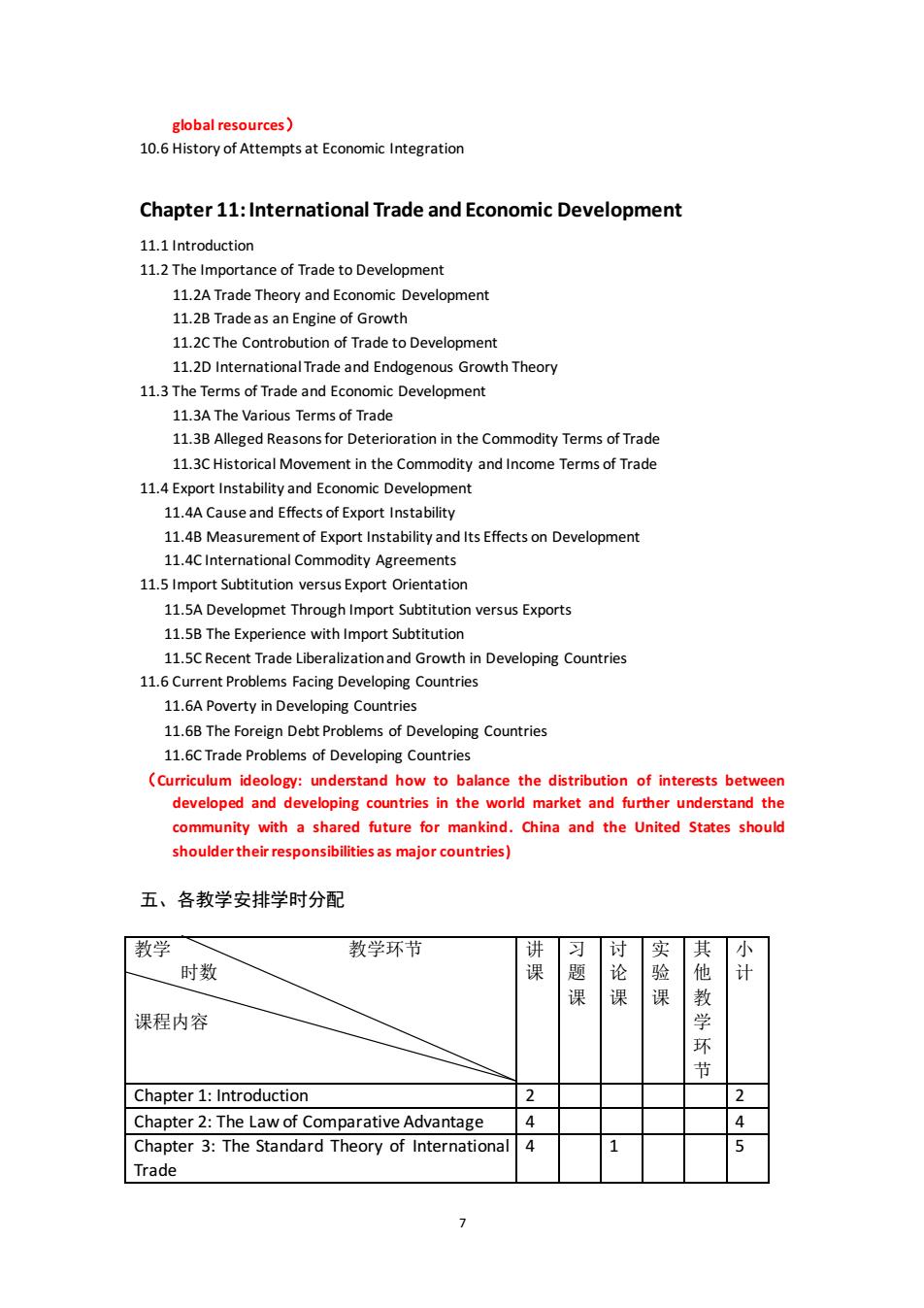
global resources 10.6 History of Attempts at Economic Integration Chapter 11:International Trade and Economic Development 111Introduction 11.2The mportance of Trade to Development 11.ATrade Theory Development 11.2B Trade as an Engine of Growth 11.2C The Controbution of Trade to Development 11.2D InternationalTrade and Endogenous Growth Theory 11.3The Terms of Trade and Economic Development 11.3A The Various Terms of Trade 11.3C Historical Movement in the Commodity and Income Terms of Trade 11.4 Export Instability and Economic Development 11.4A Cause and Effects of Export Instability 11.48 Measurement of Export Instability and Its Effectson Development 11.4CInternational Commo ity Agreemen 11.Import Subtitution versus Export Orientation 11.5A Developmet Through Import Subtitution versus Exports 11.5B The Experience with Import Subtitution 11.5C Recent Trade Liberalization and Growth in Developing Countries 11.6 Current Problems Facing De veloping Countries 11.A Poverty in Developing Countries 11.6B The Foreign Debt Problems of Developing Countries 11.6C Trade Problems of Developing Countries (Curriculum ideology: understand how to balance the distribution of inter ests bety developed and developin ts in rld marke with a shared future for mar China an the United States shou shoulder their responsibilities as major countries) 五、各教学安排学时分配 教学 教学环节 讨 时数 课课 课 课程内容 环 Chapter 1:Introduction Chapter 2:The law of Comparative advantage 4 4 Chapter 3:The Standard Theory of International 4 Trade >
7 global resources) 10.6 History of Attempts at Economic Integration Chapter 11: International Trade and Economic Development 11.1 Introduction 11.2 The Importance of Trade to Development 11.2A Trade Theory and Economic Development 11.2B Trade as an Engine of Growth 11.2C The Controbution of Trade to Development 11.2D International Trade and Endogenous Growth Theory 11.3 The Terms of Trade and Economic Development 11.3A The Various Terms of Trade 11.3B Alleged Reasons for Deterioration in the Commodity Terms of Trade 11.3C Historical Movement in the Commodity and Income Terms of Trade 11.4 Export Instability and Economic Development 11.4A Cause and Effects of Export Instability 11.4B Measurement of Export Instability and Its Effects on Development 11.4C International Commodity Agreements 11.5 Import Subtitution versus Export Orientation 11.5A Developmet Through Import Subtitution versus Exports 11.5B The Experience with Import Subtitution 11.5C Recent Trade Liberalization and Growth in Developing Countries 11.6 Current Problems Facing Developing Countries 11.6A Poverty in Developing Countries 11.6B The Foreign Debt Problems of Developing Countries 11.6C Trade Problems of Developing Countries (Curriculum ideology: understand how to balance the distribution of interests between developed and developing countries in the world market and further understand the community with a shared future for mankind. China and the United States should shoulder their responsibilities as major countries) 五、各教学安排学时分配 教学 教学环节 时数 课程内容 讲 课 习 题 课 讨 论 课 实 验 课 其 他 教 学 环 节 小 计 Chapter 1: Introduction 2 2 Chapter 2: The Law of Comparative Advantage 4 4 Chapter 3: The Standard Theory of International Trade 4 1 5

Chapter 4:Demand and Supply,Offer Curve,and2 1 3 the Terms of Trade Chapter 5: Factor Endowment and the 5 Heckscher-Ohlin Theory Chapter 6:Economies of Scale,Imperfect 5 1 6 Competition and Iterational Trade apter 7:Eco Growth and Internationa 3 3 Tra Chapter 8:Trade Restrictions:Tarrifs 2 1 3 Chapter 9:Nontariff Barriers of Trade and the 2 1 3 New Protectionism Chapter 10: Economic Integration:Customs Unions and Free Trade Areas Chapter 11:International Trade and Economic 3 1 6 Development Mid-term Test,Overall Reviewing,examinationo Depending 合 计 37 2 9 48 六、指定教材和教学参考教材 指定教材:(美)Dominick Salvatore著:《国际经济学》(英文版),北京: ,2015年版 1.Paul Krugman,Maurice Obstfeld,International Economics:Theory and Policy (9th Edition):Addison Wesley Longman,2013 Policy,5th Edition, University Press,2002; 3.中共中央宣传部,习近平新时代中国特色社会主义思想三十讲,学习出 版社,2018年5月 4.习近平,习近平谈治国理政(全三套),外文出版社,2017年11月: 5.海闻、P林德特、王新奎:《国际贸易》,格致出版社,2012年: 6.薛荣久主编:《因际贸易(第6版)》,对外经济贸易大学出版社,2016 年版 .胡涵钧主编:《新编国际贸易(第2版)》,上海:复旦大学出版社, 2010年版: 推荐阅读期 《国际贸易》 《国际贸易问题》、《世界经济》、《国际经贸探索》、《国际 经济评论》、《国际经济合作》、《因际贸易论坛》等 8
8 Chapter 4: Demand and Supply, Offer Curve, and the Terms of Trade 2 1 3 Chapter 5: Factor Endowment and the Heckscher-Ohlin Theory 4 1 5 Chapter 6: Economies of Scale, Imperfect Competition and Iterational Trade 5 1 6 Chapter 7: Economic Growth and International Trade 3 3 Chapter 8: Trade Restrictions: Tarrifs 2 1 3 Chapter 9: Nontariff Barriers of Trade and the New Protectionism 2 1 3 Chapter 10: Economic Integration:Customs Unions and Free Trade Areas 2 1 1 4 Chapter 11: International Trade and Economic Development 3 1 2 6 Mid-term Test, Overall Reviewing, examination or Depending 4 4 合 计 37 2 9 48 六、指定教材和教学参考教材 指定教材:(美)Dominick Salvatore 著:《国际经济学》(英文版),北京: 清华大学出版社,2015 年版 教学参考教材: 1. Paul Krugman, Maurice Obstfeld,International Economics:Theory and Policy (9th Edition); Addison Wesley Longman,2013 2. Paul Krugman and Maurice Obstfeld, International Economics: Theory and Policy, 5th Edition, Addison-Wesley, 2000 (the ChineseVersion, China Remin University Press, 2002; 3. 中共中央宣传部,习近平新时代中国特色社会主义思想三十讲,学习出 版社,2018 年 5 月 4. 习近平,习近平谈治国理政(全三套),外文出版社,2017 年 11 月; 5. 海闻、P.林德特、王新奎:《国际贸易》,格致出版社,2012 年; 6. 薛荣久主编:《国际贸易(第 6 版)》,对外经济贸易大学出版社,2016 年版; 7. 胡涵钧主编:《新编国际贸易(第 2 版)》,上海:复旦大学出版社, 2010 年版; 推荐阅读期刊: 《国际贸易》、《国际贸易问题》、《世界经济》、《国际经贸探索》、《国际 经济评论》、《国际经济合作》、《国际贸易论坛》等
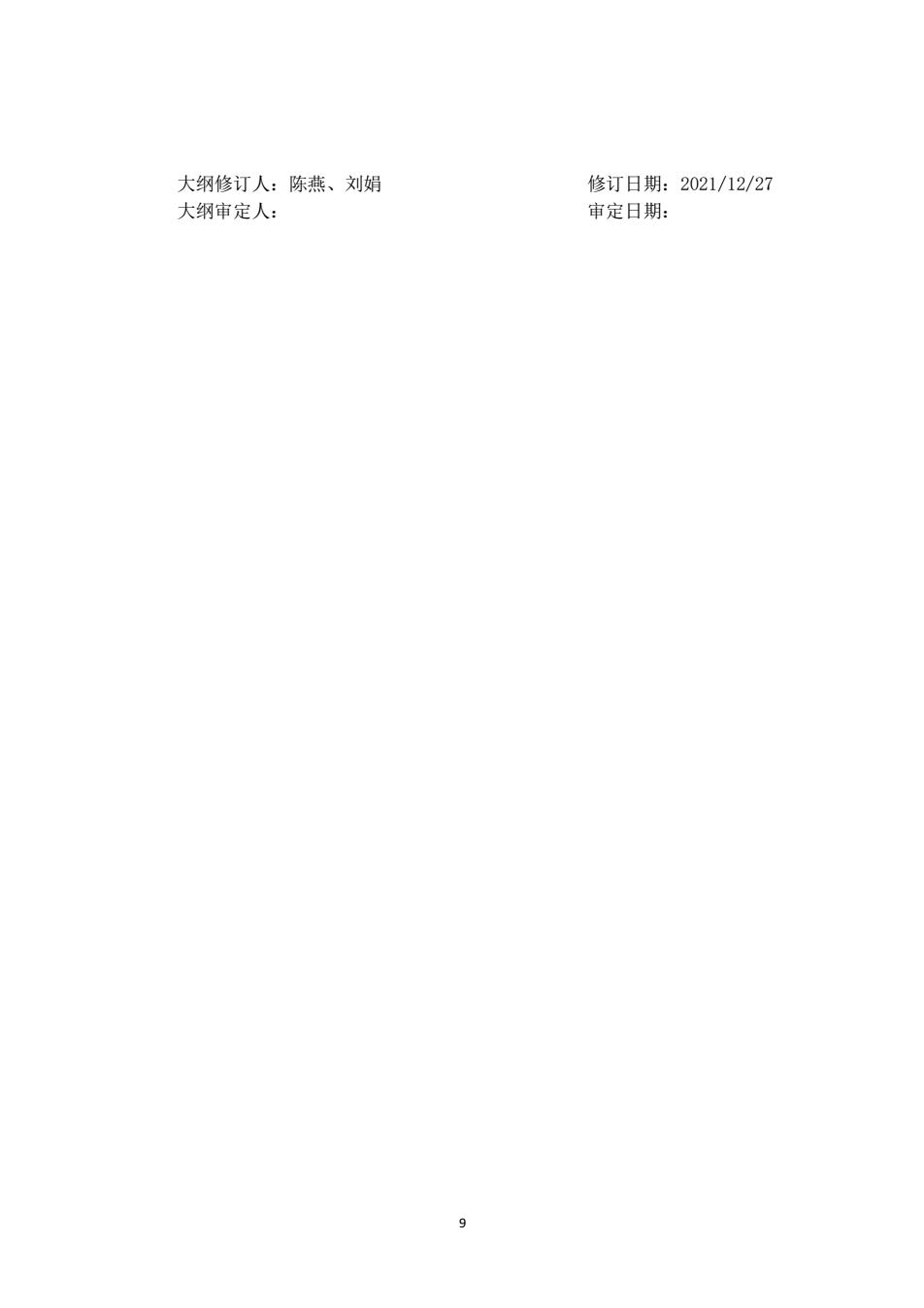
大纲修订人:陈燕、刘娟 修订日期:2021/12/27 大纲审定人: 审定日期: 9
9 大纲修订人:陈燕、刘娟 修订日期:2021/12/27 大纲审定人: 审定日期: